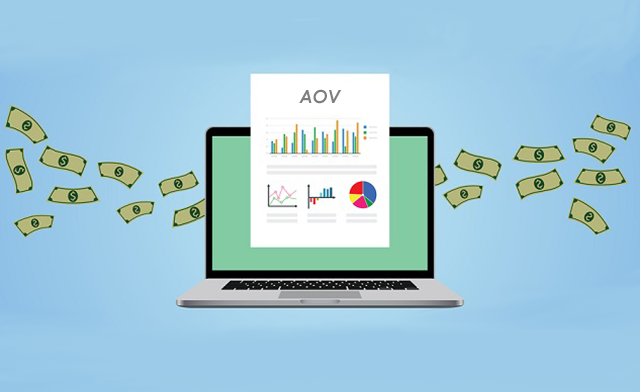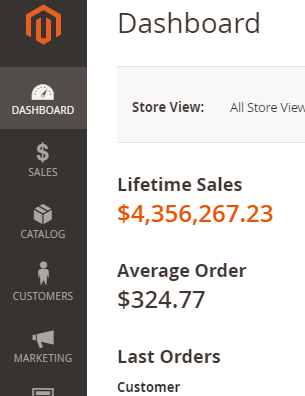
Why we need to turn our focus back to Average Order Value
Are you keeping your eye on average order value (AOV)? Magento puts it front and center in the dashboard so it must be important, right?

There used to be a lot of buzz about average order value, but cart abandonment and “customer lifetime value” (CLV) seem to get all the attention lately. But what happened to our focus on AOV? As developers and digital marketers, we work hard every day to remove obstacles in the customer’s path to purchase. For example, we speed up page loads, get user interface features working, address bugs, and security concerns. In addition, we work to include the best images, accurate product descriptions, customer reviews, and an easy to navigate design that all lead to the coveted shopping cart. In fact, getting customers to the shopping cart (as well as analyzing CLV) seems to beg for all our attention. Who has time to watch AOV? We need to find the time, because taking our eye off of this crucial measurement might derail our best efforts.
The problem with a heavy focus on cart abandonment
While average order value is focused on organizing the store, product visibility, and promoting related products, cart abandonment as a business metric is focused on the problems. When we turn our attention to cart abandonment, our tendency is to rush the customer to the checkout. At one point not too long ago, if you clicked “add to cart” on Amazon, you would be immediately directed into the checkout after adding an item to the cart. No “continue shopping” button or anything! That was extremely influential, but Amazon didn’t employ that tactic for long.
Are you sending your shoppers straight into the cart or checkout after they add an item to the cart? Have you also installed extensions or designed a promotional block for upsell and cross-sell? If you can say “yes” to both questions, that sounds like a tug-of-war! Ironically, if we make checking out super easy, with no shipping and handling, we discourage customers from spontaneously loading up their carts and increasing AOV. Cart abandonment is still important to eCommerce and should be monitored and optimized However, AOV should also be included in the process when optimizing and streamlining shopping carts.
Customer Lifetime Value, is this metric actually valuable?
CLV can be a useful yardstick, if employed correctly. For example, if concentrating on CLV guides you to take good care of your shoppers throughout the purchase cycle, then go for it! However, if calculating CLV has you chasing demographic factors (age, wage, address) that are well beyond immediate control, it might not be delivering value to you as a decision maker. There is value in defining your target customers, tactically and strategically. But for most Magento-sized merchants there is lower-hanging fruit. Further, CLV is basically a re-casting of the old marketing maxim that says keeping customers is cheaper than buying new ones; aka customer acquisition cost. While retaining customers is important for revenue, keeping the focus on AOV will fuel customer retention and loyalty.
The Importance of Average Order Value
By targeting an increase in AOV as your top-line measure of success, you have a goal that can be used to evaluate the value of the conversion rate optimization tactics that are constantly coming your way. If something smooths the path to purchase on your site, it’s going to be good for the cart abandonment number and will also enable a higher AOV. On the other hand, if you’re doing things that improve conversion rate but your AOV is stagnant or drooping, you’ll know that you have a problem with pricing, selection, product visibility, credibility or product presentation (i.e. something else). Leaning harder on cart abandonment-focused tactics in this situation runs you into another truism: diminishing returns.
Turn Your Focus Back to AOV
We recently covered up-sell and cross-sell techniques, which are sure-fire ways to address AOV. Cross-sell and upsell work from the assumption that people merely need to see more of your inventory. Don’t stop there!
Some customers might need to see more detailed photography, or gain confidence in the purchase from unfiltered reviews. Clear and vivid product descriptions unique to your store can encourage cross-category shopping. Your use of sorting and filtering play a huge role in shoppers discovering their own pairings to add to the cart. They might also need an incentive to add more items to the cart right now – an instant discount or a percentage off next purchase. Strong search tools and satisfying search results also drive increased AOV.
Make sure your customers are aware of all the options they have. For instance, we encounter merchants using simple products for apparel items that only differ in color, instead of using the configurable product type. Some of your customers would want to purchase 2 different-colored shirts, if they knew the variety was available.
It’s also possible that they aren’t connecting one product to another the same way you are, with related product offerings. Do you have your upsells grouped by brand or manufacturer … are you sure that’s how your customers make choices? Think of how you might use this product in real life and consider what else might “match” or fill a need that could follow from using the product. This takes work and insight; who is better positioned than you to do this?
Need help with your AOV optimization strategy? Contact us to get started or give us a call: 513-469-3345.